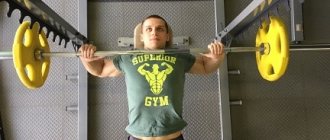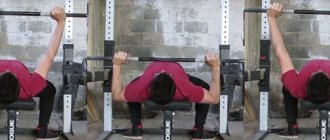10 tips on how to increase weights and results in the bench press. Find out what training, nutrition and recovery guidelines you need to follow.
The bench press is often considered a kind of universal indicator of an athlete's strength. This is not true, and anyone who is more or less productive in the gym will confirm this. However, this is one of the best exercises for developing strength and gaining muscle mass in the torso. Below are 10 tips for increasing your bench press results. What's important is that they will help you avoid plateaus - because the lack of progress for several months will unsettle anyone. But using the tips below, you can overcome plateaus and add a few pounds to your record.
Different goals - different number of repetitions
How to write "layouts"? Based on general information:
- To develop strength, perform from 1 repetition to 5-6 per set
. Strength training is the most “precise”; it does not allow the athlete to exercise “intuitively” in most cases, and does not require performing work to failure. Strength training involves performing 4-6 reps at 70 percent of your one-rep maximum, triples at 80 percent, and doubles and singles above. In this case, “technical one-rep sets” are used, when the athlete performs work for 1 repetition with a lighter weight, which he can lift for 4-6 repetitions. The difference here is that each repetition is performed in a competition technique, that is, from the starting position as at the beginning of the set, and not, as in bodybuilding, from a position in which the joints can be slightly bent; - For hypertrophy, that is, muscle growth - from 6 to 12 repetitions
. The data varies in the sources, the “golden mean” here is to do the exercise at a normal pace, and try to time how many repetitions will be completed in 30 seconds. This is approximately what a beginner needs for hypertrophy. More experienced ones can go up to 40 seconds and near failure repetitions; - Those who are losing weight don’t need a lot, we’ve already found that out
. But bodybuilding sources insist they do 15-20 reps. It doesn't really make much sense in a fitness situation. Most non-professional athletes find it difficult to maintain a safe starting position. They seriously break equipment and can get injured. Or another option is to do “aerobics with dumbbells,” that is, they perform power movements with minimal weight, and are unable to preserve muscles because of this. To ensure fat burning and not provoke muscle breakdown, it is still recommended to do two to three six-repetition strength sets of basic exercises at the beginning of your workout. And after that you can do whatever you want, for example, 20-repetition dumbbell aerobics.
The most important problem for a fitness specialist is an adequate choice of weights. Some tend to under-train, while others take each set too close to failure and overtrain. Still others avoid normal barbells and dumbbells altogether, and, being healthy, for some unknown reason, work out with elastic bands or something similar.
Ideally, you need to make at least an “estimate” in threes and calculate your RM in basic exercises from it. But those who are afraid of lifting heavy can do one “failure” approach with regular weights, find a 1 RM calculator on the Internet.
It is better to follow the percentages indicated above and lift working weights in proportion to the increase in strength, and not as you please. The approach where in one workout a person lifts 100 kg in squats, and in another with terrible technique he tries to stand up 150, because the girl of his dreams came to the gym, is not acceptable when it comes to fitness for health.
Imagine a long distance runner. He needs leg strength and sufficient power to work. But he doesn’t need to carry 100 kg of muscle mass on himself at all. Ultra-volume training is used when you need to develop strength endurance and the ability to function effectively under prolonged, repetitive load.
This option can use training schemes with 1, 2 or more minutes under load. A similar methodology is used to train for weight loss with mini-barbells – Hot Iron and Body Pump.
Various methodological techniques can be used:
- To develop strength endurance, for example, for middle-distance running, long sets with long rest can be used;
- “Losing weight” is usually prepared using various pyramids, “ladders”, and other techniques that allow you to increase the number of repetitions in the approach and extend the time under load
How many approaches should you do? There is a rule of 12 - one muscle group should not have more than 12 working approaches in total. This applies to both losing weight and gaining weight. For strength training, such rules do not work; there the load is measured in KPS, that is, the number of lifts of the barbell, and individual characteristics are taken into account. There are athletes who are not suitable for volume training, but there are also those who cannot train intensively and are forced to constantly adhere to medium intensity and high volume with rare peaks.
In practice, the following schemes are used:
- 3-12 approaches for strength training;
- 3-4 for hypertrophy and fat burning;
- “Cross-training” and circuit training schemes for increasing strength endurance
Building a Huge Bench Press
When I started training, I was a terrible bencher, but over time I have improved significantly in benching. Then I stopped. I found that nothing else worked and the results dropped. Why? Because I began to “test” strength, rather than “build” it. This is the basic principle of the system, keep building, and in order to build something, you need to understand the end goal and how to connect the parts to get the desired result.
I was a big fan of doing one rep max. I made it a point to set a new maximum every week and get upset if I didn't set a new one. I didn't take into account life, nutrition, sleep and how these things affect us in our training. And when I was exhausted and looked at my training, at my weak points, I sat down and made a plan.
Time relax
Few people follow this, but if you relax in the gym according to a timer, and not at the behest of your heart, the results will be more impressive.
The rules are simple:
- 45 second rest periods - for high-repetition strength endurance training;
- One minute for hypertrophy;
- 90 seconds for basic hypertrophy exercises;
- Anything more is for developing strength and power
If the rest time is observed, but it is not possible to complete all the planned repetitions, the weight of the weight is incorrectly selected. In this case, it is recommended to reduce it and observe time intervals for rest more carefully.
In training for beginners, it is recommended to reduce the number of approaches by 1, but remain faithful to the “layout” for repetitions in the set. This will avoid overtraining, but will help activate the muscle fibers enough for growth. In general, beginners need to pay more attention to technique, so at the very beginning of training, an 8-12 week strength cycle is recommended to develop exercise technique. Then they move on to the “ground” and “relief” schemes.
Recovery from injuries should occur according to the recommendations of a doctor. If the period of absence from training has been more than 12 weeks, you should start training according to the program for beginners, and choose working weights intuitively, based on the absence of discomfort.
Important: sometimes with injuries, the pain goes away from warming up, that is, when blood circulation accelerates. This does not mean that you need to exercise with a high load right away, but it may well mean that it is better for the trainee to warm up and do simple physical therapy exercises
The point of coaching is in the individual selection of exercises and set-repetition schemes. If you can’t make a choice on your own, it makes sense to contact a coach to draw up a program.
If your goal is to conquer weights in the bench press? Then be sure to familiarize yourself with the training methodology, which will increase your current performance by 20 kg.
Before we move on to discussing the training methodology itself, we should talk about the exercise itself, or rather, some of the subtleties that will help you improve your personal performance. Let's start with grip width, as this is a highly debated topic. As many athletes know, the grip can be medium narrow or wide.
Now you are faced with the task of choosing the optimal one for yourself, for which you should perform a small exercise. Sit on the floor and find a comfortable position for you to perform the press. Ask a friend to measure the distance between your hands. This will be your optimal grip, which you should use in the future. You may think this isn't scientific, but your body knows best how it feels comfortable doing the press.
The second secret lies in the direction of the movement. Most often, athletes squeeze the sports equipment straight and upward. However, if you look at professional powerlifters, they perform this movement differently - up and at a slight angle to the head.
And the last nuance of performing a bench press is to arch your back. Of course, this allows you to use more working weight, but this happens only by reducing the distance between the chest and the sports equipment. But this will not affect the increase in strength indicators in any way. In turn, to progress, you need to develop strength.
The basis
Although you support the barbell with your arms and chest during a bench press, it is your back that holds the rest of your body in position while you perform the exercise. Once the barbell begins to move upward due to the strength of your legs, the latissimus dorsi muscles will come into play, helping to push and accelerate the movement of the barbell towards the midpoint of the press amplitude.
The exercises in this program will work your back from every angle, providing the necessary load and intensity, which in turn will add mass and width, and improve your bench. In addition to performing deadlifts (which, by the way, are a much underrated upper back exercise) to target your lower body, you'll do a couple of lat exercises: T-bar rows and incline barbell rows. . And another excellent exercise for the upper body will “finish off” your back - pull-ups.
T-bar row
Bench training method
It should be said right away that training using this method should be carried out only after completing warm-up sets.
It is better to start with an empty bar, slowly performing 5 to 6 repetitions. Then do 3 to 4 more reps with light weights for 4 sets. After a three-minute pause, you can begin the actual training. The technique was created to develop muscles throughout the body and you will not need to make major adjustments to the training program. The method is based on the “pull-pull” principle, which implies simultaneous training of all muscles performing pushing movements on one day, and pulling on the other. The first group includes the muscles of the chest, shoulder girdle and triceps. The back and biceps belong to the second group, as do the legs.
This is due to the fact that the duration of training for the back and biceps is shorter compared to the pushing muscles group. You should train your legs once a week. The leg muscles are large and are quite difficult to train, requiring a lot of energy. If you train your legs more often, you may not achieve the desired result in the bench press.
Most training systems involve maximum load on the muscles, followed by rest to restore the body. The technique described today is based on a gradual increase in working weight. You don't have to increase the weight every session, but do it gradually, thereby creating a more realistic increase in strength and muscle mass.
At the first stage, this technique involves a two-day split, and you have no choice. The training schedule is rigid and must be followed. Unless, of course, you want to achieve your bench press goal.
The training program is quite simple. Basic exercises should be performed for each muscle group. At the same time, there will be auxiliary exercises for the development of the back, deltas, biceps and triceps.
Also, you should not increase the load on your own and follow the recommendations. Otherwise, this may lead to overtraining, but it is better that the muscles are slightly undertrained. There is no need to be afraid that you will lose muscle volume or strength indicators will decrease.
On the contrary, after the transition to normal training they will begin to increase. When training your chest there will be some nuances that we will talk about later. For example, in one session you need to perform three sets of 1, 2 and 3 repetitions, and in another - 4, 5 and 6 repetitions.
If you haven't done sets of fewer than four sets before, you should now. Such approaches lead to an increase in strength indicators, and this is exactly what we are trying to achieve.
The same can be said about the intensity of classes. When performing sets with a small number of repetitions, it is necessary to work with almost maximum weights, which also increases the intensity of the training. You should remember that the closer the working weight is to the repeated maximum, the higher the intensity of the training will be. At the same time, muscle volume will not increase so quickly, but strength indicators will increase perfectly.
In addition to training your legs once a week, you will have to slightly reduce the load on the shoulder girdle. The training program includes several types of overhead presses and the anterior deltas do not require further load. Shoulder girdle training is devoted to Monday and Friday.
On the first day of classes, you should perform swing movements with dumbbells to the sides, and on the second day the muscles that rotate the shoulder joint will develop. To improve your bench press performance, you need to have strong shoulder joints. Each training session will last about an hour. Its duration should not be increased. And now about the exercises themselves.
Monday
- Bench press;
- Dumbbell bench press;
- Side swings with dumbbells;
- French press.
Wednesday
- Pull the block in the direction of the chest, narrow grip;
- Bent-over barbell rows;
- Barbell curl for biceps.
Friday
- Exercises for rotator cuff muscles;
- Bench press;
- Dips.
Saturday
- Squats;
- Leg press;
- Leg bending;
- Block pull in the direction of the chest, reverse grip;
- Bent-over dumbbell row;
- Seated dumbbell curls.
For more details on how to increase strength in the bench press, watch this video from Denis Borisov:
Sheiko B.I.
Unlike squats and deadlifts, which we train 2 times a week, we do the bench press from 4 to 8 times a week, depending on how many times a week the athlete trains. I proceed from the fact that the arm muscles are much smaller than the leg and back muscles, so they need much less time to recover. In the 50s and 60s, weightlifters had a catchphrase: “In order to bench press a lot, you need to bench press a lot.” Very often I include 2 bench press exercises in my workout. But between them I make sure to give some kind of exercise to train other muscles, such as squats or deadlifts. After the bench press, I definitely give exercises to the pectoral muscles; if there are 2 bench presses in the workout, then after the second bench press.
They trained using exactly the same system: World bench press champions Alexey Sivokon
and
Fanil Mukhamatyanov
, bronze medalist of the World Championship
Sergei Mor
, as well as
Irina Lugovaya
prepared for the 1999 European Bench Press Championships, which she won. Only instead of doing squats, she did: leg presses, hip extension and flexion on the machine, instead of rows, she did various inclinations. This was due to a back injury. She won the European Championship with an excellent result of 152.5 kg.
This suggests that this system can be used with equal success by both triathletes and pure benchers. Let's look at 2 bench press plans, one in the (base) period, the other in the period.
So, the preparatory period.
For example, the KMS and MS group - 5 workouts per week:
Bodybuilding style bench press technique
Usually guys come to the gym and just bench press the barbell. I lowered it onto my chest and picked it up - nothing complicated. At first sight.
Working with an empty barbell is really not difficult and not even dangerous. But as soon as you start to increase weight - and beginners like to do this abruptly and thoughtlessly - problems begin with the hands, shoulders, pectoral muscles become torn, and even lumbago occurs.
The second problem with incompetent exercise technique is that very quickly people hit a ceiling, which they then cannot overcome for years. Moreover, the “ceiling” is quite modest - 60-70 kg, rarely more. And this is when training the pectoral muscles several times a week with a dozen exercises.
Do you recognize yourself? Well, you will have to work again with an empty bar to establish the technique for performing the exercise and only then begin to very smoothly increase the weights. We’ll talk about the training program a little later, but for now let’s look at the actual technique of performing the exercise.
In fact, there are many options, although each differs only in details, but the base is the same. First, let's talk about her dear, and then about the details.
The main points of the correct bodybuilding bench press technique:
- The grip of the barbell is closed (the thumb grips the bar from below).
- The buttocks are pressed to the bench, the lower back too, if possible, the legs rest on the floor with the entire foot.
- The grip width is slightly wider than the shoulders, so that in the lower position of the barbell, the hands are exactly opposite the elbows, and not to the left or right of them.
- The bar lies on the base of the palm, keep the hand straight and under no circumstances bend it back - this is fraught with injuries.
- The bar is lowered to the level of the nipples or slightly below them, so that, again, the hands are opposite the elbows and do not move forward or backward in relation to them.
- The amplitude of movement is in an arc, that is, the bar lowers to the level of the nipples or slightly lower, and rises to eye level, and not strictly upward (in the latter case, the triceps are strongly involved in the work, stealing the load from the pecs).
- At the top point, do not fully extend your arms (do not insert your elbows), maintaining tension in your chest. At the lowest point, do not throw the barbell onto your chest and also do not relax your muscles, but only lightly touch your chest. We work within the amplitude.
- Do not drop the barbell on your chest under any circumstances. We lower it under control and smoothly: 2 seconds for a negative movement (lowering) and in the process inhale air, 1 second for lifting (positive movement) and exhale.
Denis Borisov showed the bench press clearly and quite well in his video , albeit with his own characteristics:
In particular, I don’t recommend putting your feet on the bench at first - it’s quite dangerous. Too unstable position. Although the load on the pectoral muscles increases, this is a good option if you feel discomfort in the lower back. When I had lumbago in the past, I could only bench press with my feet on the bench for a couple of weeks.
Preparation period
| 1 Week | |
| Monday | 1.zh.l. — 50% 5рХ1п, 60% 4рХ1р, 70% 3рХ2п, 80% 3рХ5п (30) |
| 3.zh.l. — 55% 5рХ1п, 65% 5рХ1п, 75% 4рХ4п (26) | |
| Tuesday | 1.Seated press at an angle of 4pX6p.(24) |
| 2.Push-ups on parallel bars 6рХ5п. (with weight) | |
| Wednesday | 1.zh.l - 50% 6рХ1п, 60% 5рХ1п, 70% 4рХ2п, 75% 3рХ2п, 80% 2рХ2п, |
| 85% 1рХ2п, 80% 2рХ2п, 75% 3рХ2п, 70% 4рХ1п, 65% 5рХ1п, | |
| 60% 6рХ1п, 55% 7рХ1п, 50% 8рХ1п. (71) | |
| Friday | 2.zh.l. — 50% 5рХ1п, 60% 4рХ1п, 70% 3рХ2п, 80% 2рХ5п (25) |
| Saturday | 2.Press from behind the head 5pX5p. (25) |
| 3. Push-ups on parallel bars 4рХ6п. | |
| Total for the week: 201 climbs | |
| Intensity - 67.1% | |
The number before the exercise shows how the exercise is done in the training. P is the number of times the barbell is pressed in one approach, P is the number of approaches to a given weight. The total number of barbell lifts in the exercise is indicated in parentheses.
Please note that if on Monday the load was good in intensity, then on Wednesday it was large in volume. Although the athlete benched 80 and 85 percent weights, the intensity will be lower than on Monday due to the large number of lifts from 50 to 70%. Many people call this a “pyramid”, we call it a “marathon” and we do it once a week, but only in the base period. He hits his arms very hard, so on Friday we do one bench press with low reps per set.
When writing any plan, the most important thing is variability: alternating large, small and medium workouts, both in a weekly and monthly cycle. Therefore, it is imperative to count the number of barbell lifts (RPR), volume in kg and average weight in kg and %.
When planning the 2nd week, we pay attention to the fact that if we reduce the CPR by reducing the number of repetitions in the approach, then we increase the intensity of the workout by increasing the number of lifts of 85-90 and 95 percent weights. Like that:
In the 3rd week, you can plan 170 lifts with an intensity of 69.1%, but you can also do a very heavy load in terms of intensity and volume. Due to the fact that we will have to do a large number of barbell lifts with weights of 65-75%, the intensity will naturally decrease somewhat. Let's look at the example of 3 weeks.
On Wednesday, the athlete did a very long “marathon”, and he definitely needs mental help.
In such cases, for example, I tell Sergei Mor that his opponent Dmitry Soloviev does even more training at this time. A very important factor is to teach the athlete to tolerate fatigue and pain. Any athlete is a person with his own weaknesses and shortcomings and, naturally, sometimes it is difficult for him to force himself to do something that cannot be done or is very difficult to do. And then I tell my students: “Yes, you can feel sorry for yourself, I can feel sorry for you, your girlfriend or wife can feel sorry for you, but your opponent will never feel sorry for you. So go and continue your training." So Alexey Sivokon did the biggest “marathon” of 120 lifts, and reached 90%. After such a big week, naturally, you need to reduce the intensity. Table 1
| Zones | 1 Week | 2 week | 3 week | 4 week | Per month |
| 50% | 24 — 1200 | 13 — 650 | 41 — 2050 | 17 — 850 | 95 — 4750 |
| 51-60% | 31 — 1800 | 21 — 1310 | 54 — 3135 | 20 — 1180 | 126 -7425 |
| 61-70% | 34 — 2330 | 24 — 1635 | 84 — 5685 | 20 — 1380 | 162 — 11030 |
| 71-80% | 61 — 4700 | 61 — 4750 | 61 — 4670 | 27 — 2090 | 210 — 16210 |
| 81-90% | 2 — 170 | 11 — 950 | 8 — 680 | 21 — 1800 | |
| 91-100% | |||||
| K P Sh | 152 | 130 | 240 | 92 | 614 |
| In% | 67,1% | 71,5% | 64,7% | 67,2% | 67,1% |
| UO | 10200 | 9295 | 15540 | 6180 | 41215 |
From Table 1, the variability is very clearly visible.
During the competitive period, which lasts from 4 to 6 weeks, I do not plan “marathons”, and the maximum number of lifts in a set does not exceed 3. The number of warm-up weight lifts decreases from 50% to 70% and the number of lifts increases from 75%. up to 95%. Due to this, the intensity of training increases, see table - 2. We make an “estimate” 20 days before the competition. Moreover, experienced athletes at the level of the Russian national team do not make “estimates”. It is enough for them to work at 90-95% and they already know what result they will start with at competitions.
On Monday, for 3 weeks, we do a medium-volume and low-intensity workout. On Tuesday there is rest, this is often enough for the athlete to recover before the assessment.
Since the athlete does few lifts with weights of 90%-95%-100%, the intensity for the week decreases to 69.8% (see table -2), but it is still higher than in the preparatory period.
From the 3rd week the athlete switches to 4 training sessions per week.
On the 4th week, for the last time we increase the weekly load in volume and intensity, due to barbell lifts of 80-85 and 90 percent weights.
On the 5th week, the athlete switches to 3 training sessions a day, reducing the weekly load in terms of volume and intensity.
The last workout is more like a warm-up before the competition.
Table 2
| Zones | 1 Week | 2 week | 3 week | 4 week | 5 week | week 6 | Per month |
| 50% | 9 — 450 | 9 — 450 | 9 — 450 | 6 — 300 | 9 — 450 | 6 — 300 | 48 — 2400 |
| 51 — 60% | 13 — 760 | 15 — 870 | 12 — 705 | 12 — 690 | 9 — 540 | 9 — 540 | 70 — 4105 |
| 61 — 70% | 22 — 1520 | 21 — 1440 | 22 — 1510 | 18 — 1230 | 16 — 1120 | 7 — 490 | 106 — 7310 |
| 71 — 80% | 55 — 4320 | 56 — 2100 | 32 — 2460 | 47 — 3680 | 19 — 1480 | 2 — 150 | 211 — 14190 |
| 81 — 90% | 3 — 255 | 14 — 1190 | 1 — 90 | 8 — 690 | 26 — 2225 | ||
| 91 -100% | 3 — 300 | 3 — 300 | |||||
| KPSh | 102 | 115 | 79 | 91 | 53 | 24 | 464 |
| In% | 71,6% | 72,7% | 69,8% | 72,4% | 67,7% | 61,7% | 70,8% |
| UO | 7305 | 8360 | 5515 | 6590 | 1480 | 32840 |
When comparing the calculations of the preparatory and competition months (see and ), it is clear that while reducing the number of barbell lifts during the competition period, we increased the intensity of training. In weeks 5 and 6, we reduce both the amount of CPS and the intensity of training. This is necessary so that the athlete can recover better before the competition.
Progression in the bench press is a key factor in training effectiveness for almost all beginning lifters. You always want to bench press more than others and boast that in just a couple of months of training you have bench pressed an impressive amount of weight. However, within the framework of this article, we will not consider the correctness or incorrectness of this approach, but will analyze the most pressing question for beginners - how many times a week should you do the bench press?
Bench press technique to increase results
The first thing you should pay attention to is technique. It is this that will allow you to reveal your hidden potential, save energy and protect from injury. I wrote about the correct technique for performing the bench press in a separate article, and there is also a video there. Moreover, the video presents a “bodybuilding” technique of execution. In order to quickly overcome the first hundred on the bench press, it is best to press with a bridge, with a wide stance of the arms (as in the picture below).
This technique is used by powerlifters. These recommendations slightly reduce the range of motion of the barbell, which in our case is to our advantage.
You should devote at least one day out of 3-4 days of training to the bench press technique. Practice your bench press technique with a weight of 50% of your maximum.
Goals as the basis for training
To answer the main question of the article, you must first decide on your goals in the gym. Namely, what do you want to achieve? This could be strength in multiple exercises, strength in a single exercise (such as the bench press), endurance, muscle gain, or simply staying in good physical shape. Your training regimen will depend on what goal you have set for yourself. There is no universal answer to the question: “how often do you do the bench press?” - does not exist. It all depends on what you want to end up with.
Let's take an example of the 2 most common goals - gaining mass and increasing strength.
Goal: gaining muscle mass (muscle pumping, definition, etc.)
For the purpose of muscle growth and gaining muscle mass, it makes no sense to perform the bench press more than once a week. This is due to the fact that on each training day we pump certain muscle groups, so doing the bench press more often during the week will lead to damage in pumping some other muscle group.
In bodybuilding training, we only perform bench presses on chest day. That is, our goal is not to develop performance in one or several exercises, but to load the target working muscles. And the bench press in this case acts only as a means of providing this load.
Goal: increasing strength in a specific exercise
This goal is usually set by athletes who want to engage closely in powerlifting, bench press, or simply want to bench press a lot without competing. In this case, the training will differ significantly from bodybuilding, since the basis will not be pumping each specific muscle group, but increasing performance in one or more exercises.
For this purpose, the bench press can be performed 2 times a week. In this case, one of the workouts should be heavy (low number of repetitions, maximum working weight, one-time maximum training), and the other should be light (many repetitions, many approaches). Thus, specifically the bench press will be trained both in a heavy strength manner and in a high-repetition volumetric manner.
The main mistakes athletes make when training bench press strength are doing heavy bench press training too often, which seriously depletes the nervous system and leads to long-term stagnation in performance. The optimal method is the one given above, which is based on a combination of heavy strength and high-repetition volume training.
Ending
From about the middle of the bench press amplitude, the triceps are involved in the exercise. These are the muscles that push the barbell to its final position, so the strength of the triceps - especially the long head - is absolutely necessary for the successful execution of the press.
When you work the long head of the triceps, you will feel tension near your elbows. In this program, you will "attack" this strategically important anatomical element with the close grip bench press and the French bench press. You can add a standing French press to your program to aesthetically balance this muscle group, but remember that it is the long head that provides the necessary power to push heavy weights.
French bench press









